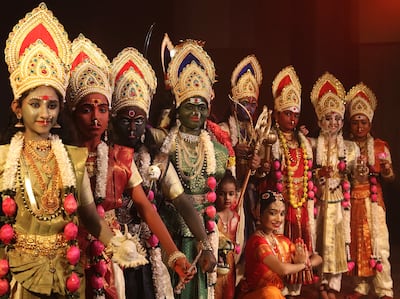The Indian festival of Navratri culminates in Dussehra on day 10, which falls on Saturday this year.
Celebrated by many Hindus around the world, the festival is a homage to divine femininity, specifically the incarnations of the goddess Durga. “Nav” stands for the number nine and “ratri” translates as night.
Here are nine things to know about Navratri and Dussehra.
1. The power of Durga

Like many deities from the Hindu pantheon, the goddess Durga has different names, avatars and traits. Prime among these is Shakti or feminine strength. Shakti is said to have the combined powers of a trio of Hindu gods: Brahma the creator, Vishnu the preserver and Shiva the destroyer.
Durga puja is an important part of Navratri celebrations and is conducted from day six to day 10. Idols of the goddess are adorned in bright clothes and jewels, with various prayers, worship rituals and celebratory dances taking place in homes and temples through the night.
2. Roots and offshoots
The origin story of Navratri states it is celebrated because of the slaying of the king of demons, Mahishasura, by Durga after a battle of nine days. Mahishasura's power lay in the myth that he could not be killed by either a man or an animal, so the gods banded together to create the feminine Shakti to defeat him.
As such, the festival also signifies the power of good over evil, and perpetuates values such as bravery and controlled strength. The maternal side of the goddess, meanwhile, is reflected in prayers for the creation of new life via a good harvest.
3. Fasting and other rituals

Many believers abstain from food in the daytime on the first two, last two or all nine days of Navratri. Others refrain from consuming non-vegetarian dishes. Meat aside, dishes are often prepared without onions and certain grains and pulses during the nine days. Rock salt is used instead of iodised salt.
Devotees also wear different colours of clothing over the nine days based on which incarnation of the goddess is being celebrated, from orange on day one in tribute to the earth goddess Shailputri and white on day two for the goddess of purity Brahmacharini, to peacock green on day nine for Siddhidatri, goddess of strength and intelligence.
4. Milestone celebrations
Even among the nine nights of the festival, a few are considered more auspicious.
While Durga puja starts on day six, Durgashtami falls on the eighth day (October 11 this year). As part of this celebration, the weapons purportedly used to kill the demon Mahishasur are worshipped in a ceremony called astra puja. Another ritual includes washing the feet of nine young girls and feeding them sweetmeats, in ode to the incarnation of goddess Gauri.
Day nine marks Maha Navami, when the goddess is worshipped as Saraswati, who represents wisdom and education. Alongside the idol, many devotees worship books, musical instruments and, in modern times, even computers and laptops and adorned with red vermilion powder.
5. Navratri by the season
While the autumnal celebration is termed maha (or main) Navratri, the festival is also celebrated during the three other seasons albeit not with as much gusto. This includes: Chaitra Navratri in the spring; Magha Navratri in the winter and Ashadha Navratri during India's monsoon season.
6. Banishing demons during Dussehra

The 10th day after Navratri is celebrated as Dussehra or Vijayadashami, and marks the day Rama, the protagonist of the Hindu tome Ramayana, destroyed the 10-headed demon king Ravana. Once again symbolising the triumph of good over evil, celebrations include the burning of the demon's effigies alongside bonfires, fireworks and feasts.
People don vibrant new clothes, wish each other “Happy Dussehra”, and send messages hoping friends and family find happiness, prosperity, success and good health.
7. Buying gold and worshipping cars
Making new investments is considered auspicious on Dussehra, of which buying gold tops the charts for many Indians. The precious yellow metal is seen as the ultimate symbol of wealth and it is thought that buying gold on certain days such as Dussehra will attract further fortune in the year ahead.
Although vehicles are not considered an asset, some people also choose to get the delivery of their new cars on Dussehra. Cars, old and new, are also bedecked in garlands of marigold flowers and a hanging ornament made of lemon and green chilli to ward off bad luck.
8. Celebration by state

Commonalities in prayers aside, the different states of India have specific ways in which they celebrate the festival. In Gujarat in the west of India, for instance, people partake in the upbeat dance forms of garba and dandiya during Navratri, while the state of West Bengal is known for its beautifully decorated Durga puja pandals.
Dussehra celebrations too differ from state to state. Ram Leela plays are common in north India, with excerpts of the Ramayana enacted in public and private performances. In South India, especially Tamil Nadu, festive displays of golu or kolu dolls are put up.
9. The Hindu calendar
The reason for the changing dates of these and many other Indian festivals is down to Panchanga or the Hindu calendar, which follows lunisolar months – and so is quite different from the traditional Gregorian calendar.
Navratri and Dussehra are celebrated in the Hindu month of Ashwin, while the next big Indian festival, Diwali, falls in the month called Kartik.
A version of this story was first published on October 3, 2024








